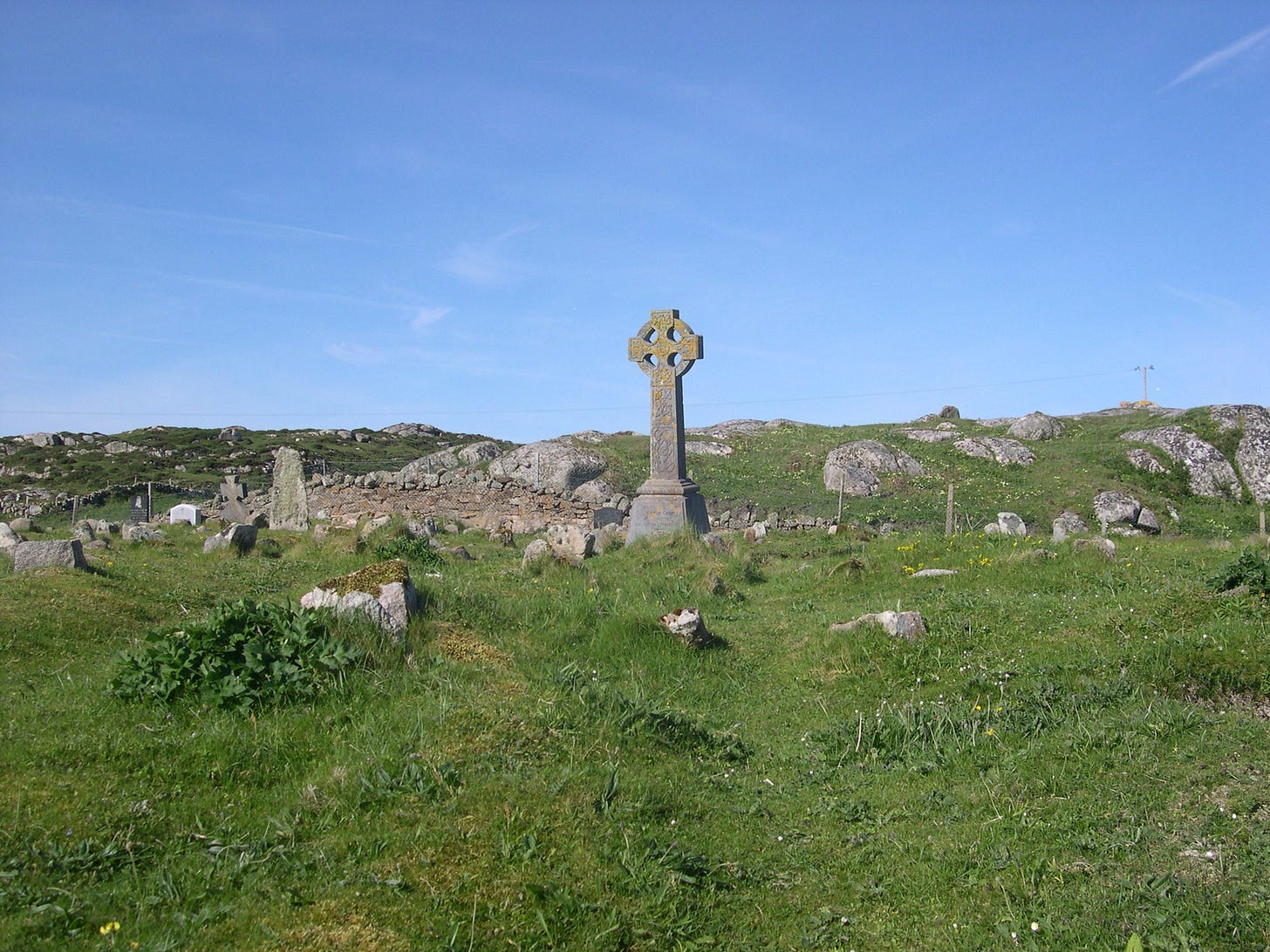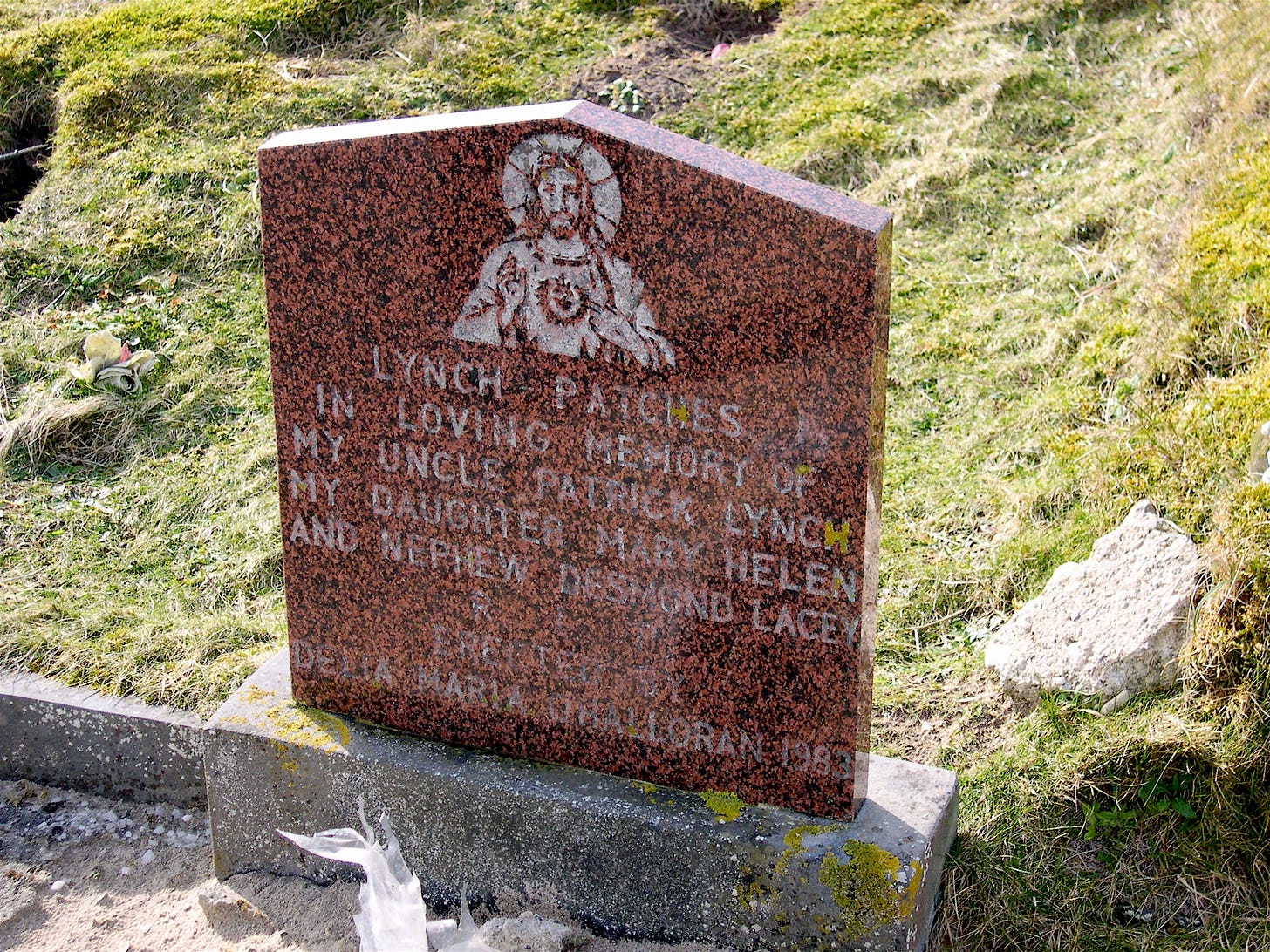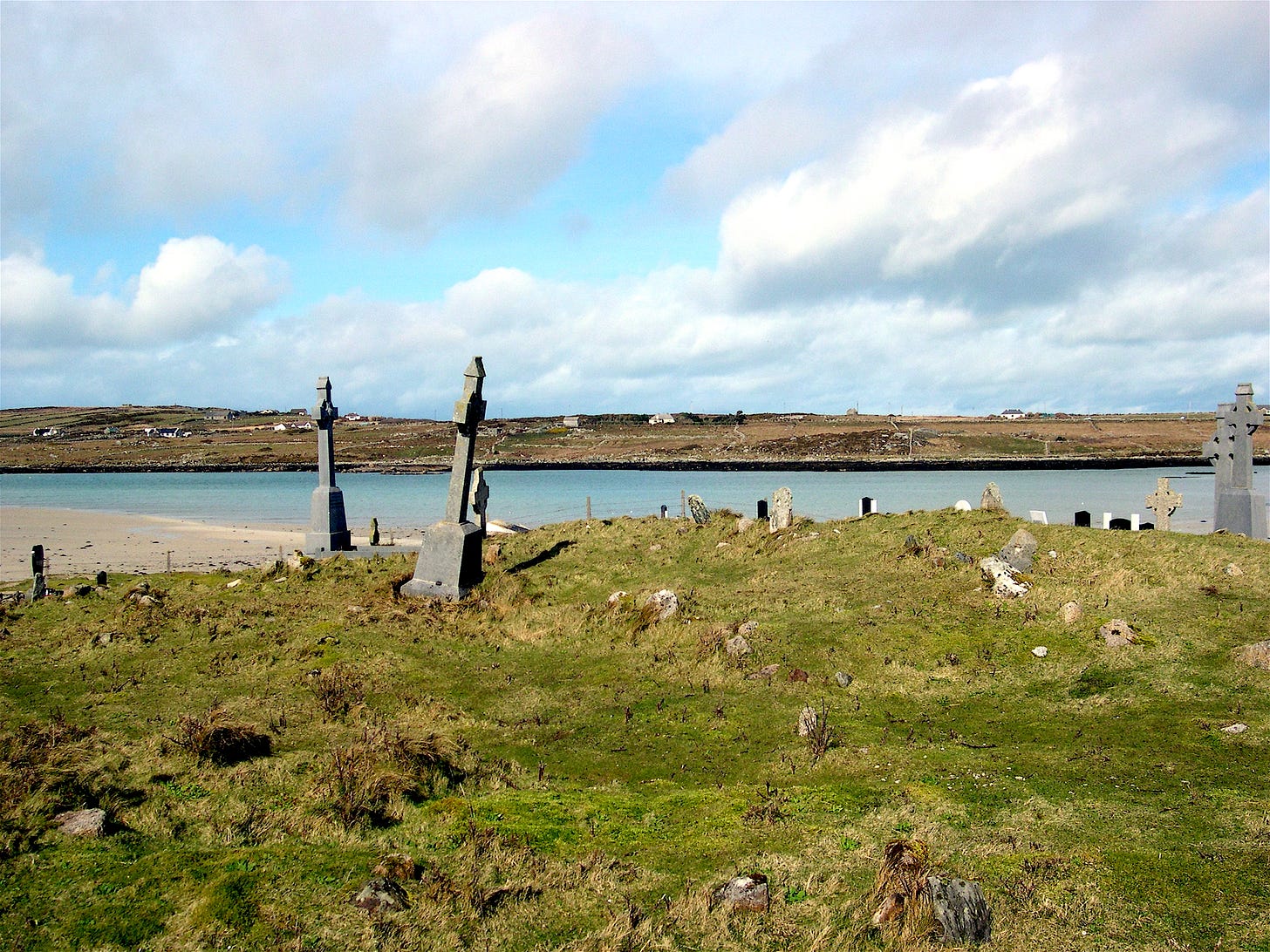There was little extra room in St. Brendan’s Graveyard on Omey Island, just off the west coast of Ireland. I was there searching for the graves of my mother’s family, the Lynches. The ancient cemetery, filled with gravesites on rocky, uneven terrain, sloped down toward the strand where the waters rose and fell with the tides. I walked around the stones with Celtic crosses, some with the initials IHS (in the Holy Names of Jesus) embedded into the pagan symbol. Others were merely marked with dates. And some, through centuries of standing up to fierce gales and rain, were tilting one way or another, wearing away with the weather. Still other graves, clustered together, formed a ringed depression in the ground. Small, nameless, dateless rocks marked their sites.
Look at this. No tombstone, no marker—just a rock. Am I standing on a mass grave from the Famine? I wondered. Wood too scarce to spare, these Famine Irish were carted to their final resting places in a coffin with a trap door. Down the dead went into a common pit, the coffin carried back to the mainland to be reused the next day.
But these people were some of the lucky ones. I’d seen the ruins of old cottages on the mainland, the thatched rooves caved in. Whole families often died of starvation or typhus on the same day, no one alive to keep the fire going and the thatch dry. Heavy with the weight of the moist climate, the roof pulled in the stone walls, burying the inhabitants inside, the cottages themselves becoming gravesites. I’d driven by many of these ruins on the peninsula, untouched for over 150 years.
Where, oh where were the Lynches? Their cottage was still standing. They had to be in a cemetery.
That afternoon, I had knocked at the rectory in Claddaghduff next to Our Lady of the Sea Church, perched on the edge of the beach.
A bit disheveled, his collar askew, the priest seemed irritated to have his football game on T.V. interrupted by another clueless Yank. I explained: I had found the family homestead, but thought I could get more information at the cemetery. But I’d driven around and around the peninsula, unable to locate a graveyard.
“The graveyard is over on Omey Island,” he snapped and told me to drive over there.
Drive through the ocean to the island? He must really want to get rid of me, I told myself.
I drove the winding road down to the strand where the tide had parted, opening a passage to a small landmass in the distance. Wow, you could drive over to Omey Island, I thought. But I’d had too many Midwestern experiences with vehicles stuck in the mud. I had visions of the rental car sinking down in the sand, water pouring into the window. Instead, I walked. The sand was wet and clingy, and after about a half mile, I took off my shoes and socks and kept walking, leaving Our Lady, Star of the Sea behind me.
In St. Brendan’s, I began to despair. Some gravesites had identifying names, but most had been lost to the elements, or were only marked symbolically. A small currach enclosed in plexiglass lay next to one grave, a tiny drawing of a guitar was engraved on another, a bingo card on still another. I came upon a Celtic cross monument that marked those who had lost their lives in the Cleggan Disaster, a terrible fishing accident in 1927. All were buried in a common grave. Some from a small village called Rossadillisk on the mainland, the others from the island of Inishbofin.
I read through the list of the Cleggan Disaster names. No Lynches here, thank God. But would I ever find my ancestors’ burial site? The sites here were so very different from those at home. At least on the surface, my hometown pioneer cemetery in Iowa had a semblance of order with members clustered together around a prominent family marker. But this graveyard contained so much more history, and so many more people, all jumbled together in such a relatively small space.
How would I ever find my people here?
It was no use. I might as well give up and hike back across the strand. But I kept wandering, looking down at the ground. Perhaps I was just going to have to resign myself to the fact that I couldn’t find my family. Perhaps this trip to Omey was teaching me that the wind eventually erases not only our names but our beings. The wind had blown across this pink granite rock so long and hard to form the sand surrounding me.
I turned and looked up. Across the strand, I could see the outlines of the lazy beds in the tillable part of my ancestral farm. I imagined my family in that small field, spading up what turf there might have been, creating a kind of raised bed. Then the farmers gathered up seaweed from the shore, and with the help of their donkey, hauled the load in creels, or willow baskets, to the beds. The farmers spread the seaweed over the turf, allowing it to decompose and become rich fertilizer. Then come spring, they planted potatoes.
I looked down again. There it was! Lynch, the family name. Patches, the name of the townland.. And the emblem of the Sacred Heart of Jesus. Small, made from pink granite. Yes, with the names of my uncle Patrick and a couple of other cousins. I’d found a few relatives at this site, a piece of ground about as big as my kitchen table. But where were the others? There were no other Lynches anywhere else in this cemetery. Were they buried in another place?
I thought about the rest of my family, those who had immigrated to the United States. How wonderous the rich Iowa soils must have looked to them. Topsoil as much as three feet deep, held in place by penetrating prairie roots, full of nutrients built over thousands of years by the decomposition of the plants. Dead and dried prairie grasses and wildflowers stacked on top of each other, mixed with bacteria, mold and fungi, with dead insects and bison droppings. Shriveling layers, all composting, breaking down in a common grave to create rich soil. The plow opened the plains. No need to make your own soil from seaweed here. Then I reminded myself of the destruction of that plow, how many thousands of acres it tilled, the ground vulnerable to disturbance, to over-production, to drought and wind, the topsoil blowing away.
Once back on the mainland, St. Brendan’s in my rearview mirror, I’d called my cousin, a man I was yet to meet. The bartender in Sweeny’s Pub had written Gerry’s name on a scrap of paper with instructions to call him. He would be my cousin.
“But Gerry, where are all the rest of the graves?”
“What do you mean?”
“I only found a few relatives. Where are all the others? The great-grandparents, the uncles and aunts?
“Oh, they’re all there, Mary.”
“All there? How could that be? The graveside’s only big enough for two people.”
“They’re all stacked up.”
“Stacked up?”
“One buried on top of the other, sinking into the sand. We just lay the coffin on the site, throw a big fishing net on top of the whole thing. It doesn’t take long for the coffin to settle. One goes down on top of the next.
“Are you sure? How do you know, Gerry?”
“Oh, I know.”
“But how do you know?”
“I’m the gravedigger, Mary.”
Please consider becoming a paid subscriber to Mary Swander’s Buggy Land. All proceeds go to AgArts, a non-profit, designed to imagine and promote healthy food systems through the arts.
Listen to Mary Swander’s Buggyland podcast, part of the Iowa Podcast Collaborative:
Please support my colleagues in the Iowa Writers Collaborative:









Wow! Yes, I agree with Bonnie. Great telling. Brilliant last line. Love how you weave together the stories and earths of Ireland and Iowa.
Archetypal Irish folk telling. Great piece.